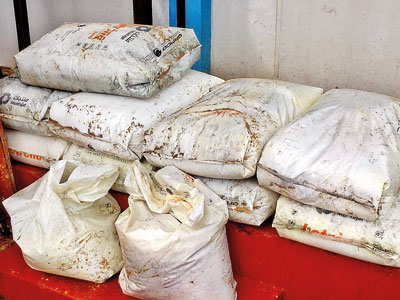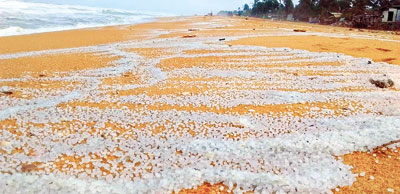News
Still no answers about X-Press Pearl damage

More burned rubble and twelve bags of nurdles (plastic pellets) were washed to the shores of Moratuwa, Ratmalana and Angulana due to stormy weather conditions experienced on friday. Pix by Reka Tharangani Fonseka
The government this week again came under sustained pressure to release information about the damage caused by the oil spill and release of toxic chemicals and plastic caused by the X-Press Pearl ship disaster.
Environmentalist Pahiyangala Ananda Sagara Thera said he wrote to the Central Environmental Authority (CEA) and Marine Environment Protection Authority (MEPA) last week pointing out that if the extent of the damage is known experts would be able to take better measures to reverse the damage.
“No one knows the underwater situation, there was no testing carried out to see what chemicals have mixed with seawater. To my knowledge there is not even underwater footage collected,” the thera said.
“Sri Lankan waters have beautiful coral species and endemic marine life that could be affected, so investigations should be expedited and reports released quickly to spur action,” he said, adding that he is planning to write to President Gotabaya Rajapaksa calling for a presidential committee to be appointed to investigate the issue.
Opposition Leader Sajith Premadasa tabled 11 questions in parliament on Friday.
Mr. Premadasa asked about the progress of investigations into how the X-Press Pearl caught fire and sank in May-June and whether those responsible had been identified.
He asked what measures had been taken to estimate the full extent of damage to the sea, shore and mangroves, whether the cause of death of numerous turtles, dolphins and other marine life following the accident had been ascertained, and what work had begun to reverse the damage and estimate the expense of this process.
Mr. Premadasa asked whether the government had learned which harmful chemicals had been released into the sea, whether an oil spill had taken place, and in what volumes these spills had occurred.
The answer remained much the same as it has been ever since the accident: the Minister of Ports and Shipping, Rohitha Abeygunawardena, said his ministry and the Crime Investigation Department were conducting investigations and would reveal the outcome when the investigations were completed.
Mr. Abeygunawardena said MEPA was working with the Department of Wildlife Conservation and the Marine Research Institute and the Government Analyst to investigate the cause of deaths of turtles and other marine life found dead on Lankan beaches.
The Minister said that the government is calculating the damage and expenses for restoring the damages caused.
“Currently they don’t have any evidence that poisonous chemicals have become mixed with seawater. However, samples have been sent to relevant authorities,” he said. He claimed that most of the plastic pellets washed into the ocean from the ship’s cargo containers had been removed from the coastline. The X-Press Pearl was carrying an estimated 70 billion plastic pellets in containers.
Meanwhile, The Pearl Protectors marine conservation organisation claimed it had been misquoted in an article last week in the Sunday Times that quoted it saying environmentalists had been restrained from monitoring the impact of the ship disaster because the CEA had declared the shipwreck site a hazardous area and because of rough monsoon weather.
A statement released by The Pearl Protectors states: “As a volunteer organisation, what we are working on is restoring our shorelines from the pellet spill that occurred. Volunteers could not be mobilised for beach clean-ups when the pellet spill occurred due to the pandemic travel restrictions at the time and since the beach areas that had debris and waste were contaminated with toxins. Billions of plastic pellets are estimated to be at sea.
“The Central Environmental Authority had issued guidelines for the said areas to be declared as hazardous areas. With travel restrictions being eased now, The Pearl Protectors have launched the ‘Nurdle-Free Lanka’ campaign to clean the beaches with volunteer mobilisation and community engagement.”




